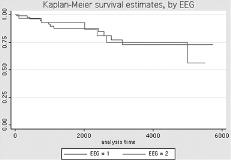POLYSPIKE AND WAVE DOES NOT PREDICT GTCS IN CHILDHOOD ABSENCE EPILEPSY
Abstract number :
1.233
Submission category :
Year :
2004
Submission ID :
4261
Source :
www.aesnet.org
Presentation date :
12/2/2004 12:00:00 AM
Published date :
Dec 1, 2004, 06:00 AM
Authors :
1Steven L. Kugler, 2Ryan Cauley, 1Neel Shah, 3David E. Mandelbaum, 4Deb K. Pal, and 2Martina Durner
About 40% of children with Childhood Absence Epilepsy (CAE) develop generalized tonic-clonic seizures (GTCS) but the clinical and electrophysiological factors predicting this evolution are not well defined. Some clinicians believe that polyspike and wave (PSW) pattern on the EEG marks the later development of GTCS when seen in CAE patients. However, there is no firm epidemiological evidence for this proposition. We therefore tested the hypothesis that PSW predicts GTCS in typical CAE patients. We used a cohort design to measure the incidence of GTCS in CAE patients after diagnosis and to assess predictive factors. We identified 115 patients (60% female) with typical CAE (defined by the ILAE 1989 criteria) who first visited our outpatient epilepsy clinic between 1992 - 2003. We obtained longitudinal data on the incidence of GTCS by a combination of chart review, postal questionnaire and telephone interview. Final response rate was 84%. Using survival analysis, we compared the incidence of GTCS in CAE patients with either simple 3Hz spike and wave or PSW patterns on EEG. We looked at the effect of age, sex and family history of epilepsy on GTCS incidence by multivariate analysis using a Cox proportional hazards model. The mean age of CAE onset was 6.5 years; mean duration of follow-up was 5.3 years; 30 (26%) patients had PSW on their EEG. Incidence rate of GTCS was 8 per 100,000 person-days of follow-up. The incidence rate ratio (RR) for GTCS in patients with PSW compared with simple 3Hz EEG pattern was 0.99 (95%CI:0.37-2.64): figure 1 shows GTCS incidence since onset of CAE (days) by EEG (1=3Hz, 2=PSW). In multivariate analysis, only age of onset after 8 years significantly increased risk of GTCS: Hazard Ratio 3.6, 95%CI:1.2-10.1, adjusted for sex, family history of epilepsy and EEG pattern (PSW or 3Hz). There was no evidence that PSW predicted GTCS development in CAE patients, GTCS incidence was identical for CAE patients with simple 3Hz vs PSW. A later age of onset was the best and only independent predictor of GTCS in CAE patients; PSW was not more common in older onset CAE. These results have implications for the choice of first-line AEDs, especially if valproic acid is being chosen because of PSW on the EEG.[figure1] (Supported by National Institutes of Health: NS37466, NS27941, DK31775, and the Epilepsy Foundation of America.)
